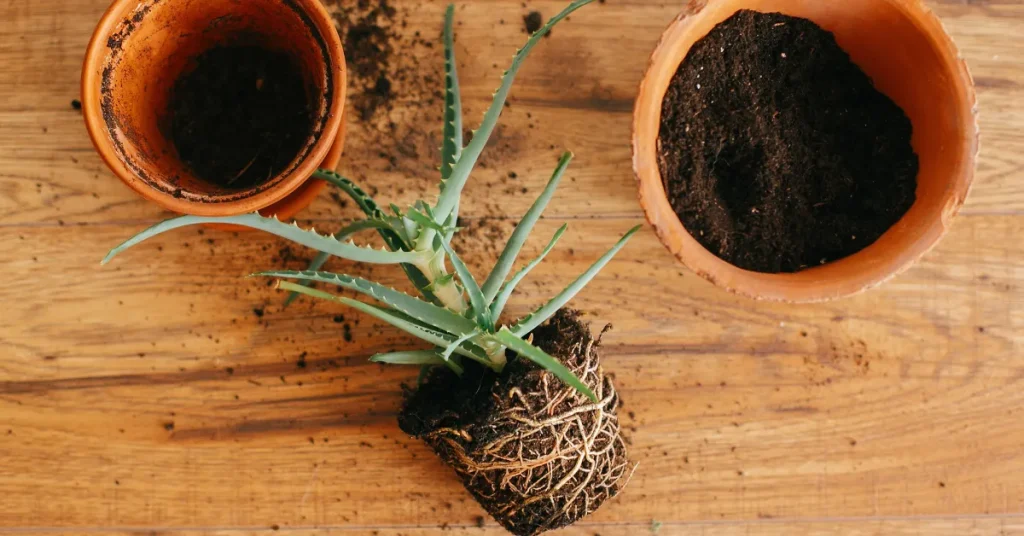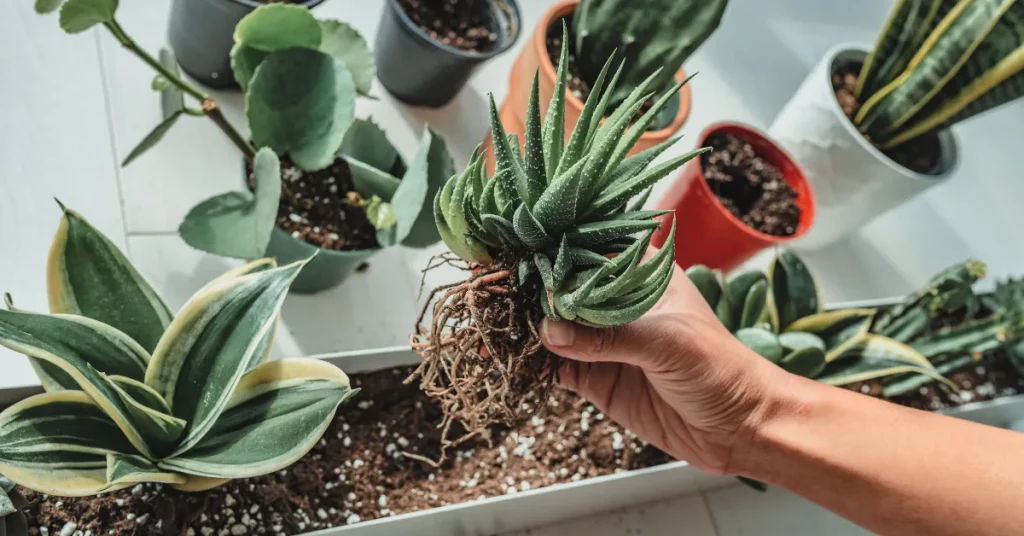Cactus roots are typically shallow, often extending only 4 to 6 inches deep. Some large species can have deeper roots, up to 2 feet.
Understanding the depth of cactus roots is crucial for both gardeners and desert adventurers. These resilient plants have evolved to thrive in arid environments, where they have adapted a shallow but wide-reaching root system to maximize water intake from light rains.
This root depth allows cacti to quickly absorb moisture before it evaporates or sinks deeper into the ground, away from the plant’s reach.
Cacti are a fascinating example of nature’s ingenuity; despite harsh conditions, they maintain vibrancy, showcasing remarkable water-efficient mechanisms.
Remember, while some variations exist, the shallow root depth generally holds across the diverse spectrum of cactus species, each uniquely tailored to its environment.

Unveiling The Depths Of Cactus Roots
Cacti are renowned for their hardy nature and unique adaptations. Central to their survival in arid landscapes are their roots. Unseen, these roots stretch and thrive beneath the unforgiving desert soil.
Cactus roots hold secrets to their survival. Unlike towering trees with deep root systems, many cacti opt for a shallow, widespread approach. This architecture allows them to quickly capture water from brief desert rains.
Root Characteristics Across Cactus Varieties
Not all cactus roots are designed the same. Across species, variations appear. Let’s explore these differences:
- Saguaro Cactus (Carnegiea gigantea): A shallow root system that spreads out as far as the plant is tall.
- Barrel Cactus (Ferocactus): A slightly deeper root system with one central taproot and smaller feeder roots.
- Pincushion Cactus (Mammillaria): Mostly shallow roots, but some species might develop a taproot.
These formations optimize water absorption and support during extreme weather. Cactus roots can be as complicated as their spiny exteriors are striking.
| Cactus Type | Root Depth | Root Spread |
| Saguaro Cactus | Shallow | Wide |
| Barrel Cactus | Varies | Medium |
| Pincushion Cactus | Shallow | Narrow |
Each species of cactus adapts its root system to its environment. Thriving across deserts, they account for variances in rain, soil type, and other factors. A deeper understanding of cactus roots shines light on their remarkable resilience.
Evolution’s Ingenious Solution: The Adaptation Of Cactus Roots
Cacti are masters of survival in the harshest environments on Earth. Their roots have evolved through time turning scarcity into opportunity. Each root system is a testament to evolution’s creativity, allowing cacti not just to survive but thrive in deserts.
This post explores the remarkable adaptations of cactus roots that make these prickly wonders the ultimate desert dwellers.
Survival In Arid Climates: Root Modifications
For cacti, every drop of water is precious. Their roots dive deep and spread wide to capture every bit of moisture. Here’s how they do it:
- Shallow and widespread to absorb surface water fast.
- Expandable to store water during rare rains.
- Elastic to shrink during droughts, avoiding damage.
These modifications ensure cacti maximize their water intake, and minimize water loss. It is a remarkable showcase of evolutionary adaptation to extreme water scarcity.
The Role Of Mycorrhizal Associations
Cacti roots are not alone in their quest for survival. They partner with mycorrhizal fungi, forming a win-win relationship. This interaction is vital for the cacti, and here’s why:
| Mycorrhizal Benefit | Impact on Cactus |
| Enhanced nutrient uptake | Allows cacti to access more nutrients with less effort. |
| Improved water absorption | Helps cacti maintain hydration in dry conditions. |
| Disease Resistance | Protects cacti from root pathogens. |
These associations are crucial for cacti, ensuring they get the most out of their environment without exerting unnecessary energy.
Measuring Root Depth: Techniques And Challenges
The depth of cactus roots often surprises those accustomed to more traditional plants. In the unforgiving desert, cacti have adapted with roots that span vast horizontal distances but often remain shallow.
However, measuring just how deep and wide these roots go presents a unique set of challenges.
Excavating Facts: Study Methods
Scientists employ a variety of techniques to study cactus root systems.
- Soil excavation: This involves carefully digging away the soil to reveal root depths.
- Clear soil blocks: Extracted intact for study in a controlled environment.
- Ground-penetrating radar: Provides images of roots underground without digging.
- Rhizotrons: Specialized glass-faced observation tunnels installed in the soil.
The Difficulty In Determining Precise Depths
Root depth measurement is not without its hurdles. The primary challenges include:
| Challenge | Impact |
| Soil hardness | Makes excavation tough, risking root damage. |
| Root fragility | Roots can break, leaving parts unrevealed. |
| Environmental concerns | Studies must not harm the local ecosystem. |
| Technology limits | Not all methods show every root detail. |
The Impact Of Environmental Factors On Root System Depth

Cactus roots vary in depth. The environment plays a key role. Soil and water are the main factors. We will explore how they affect root systems.
Soil Composition And Its Influence
The type of soil determines root depth. Cacti adapt to different soils. Let’s see how soil changes the root system.
- Sandy soil – Roots spread out shallowly.
- Clay soil – Roots may go deeper for stability.
- Rocky soil – Roots navigate around obstacles.
Each soil type leads to unique root structures. Cacti are resilient. They thrive in varied soils.
The Effect Of Water Availability
Water is crucial for cactus roots. Let’s look at how water affects their depth.
| Water Condition | Root Depth |
| Dry conditions | Shallow roots to catch surface water |
| Wet conditions | Deeper roots if surface water is scarce |
Roots adjust to find water. They can spread wide or grow deep. This ensures survival in diverse conditions.
Cactus Roots In Cultivation Vs. Wild Environments
Understanding cactus roots is fascinating. Cacti survive in harsh conditions. Roots are key to survival. In homes and deserts, roots adapt uniquely. Let’s dive into cactus root secrets in different settings.
Nurtured Growth: Root Behavior In Gardens
Cactus roots in gardens grow shallowly. This helps them soak up water fast. Gardeners control water and nutrients. Hence, managed cacti show distinct root patterns. Consider these points:
- Garden cacti have shorter, denser roots.
- Regular watering keeps the roots compact.
- Soil mix affects root depth and spread.
Plant pots restrict root growth. Hence, cacti adjust to containers. Root development is vital for healthy cacti indoors.
Natural Extremes: How Wild Cacti Develop Differently
In the wild, cacti face extreme weather. Roots stretch wide and deep for moisture. Below are key differences in wild cactus roots:
- Wild cacti have expansive root systems.
- Roots can reach up to 15 feet in deserts.
- Desert rains trigger roots to grow quickly.
Desert roots reflect survival strategies. Wild cacti show impressive resilience. Their roots mirror the fight for life in arid landscapes.
The Myths And Realities Of Cactus Roots

The Myths and Realities of Cactus Roots often stir up curiosity. There’s a desert of misinformation out there. Let’s plant some facts and watch the truth about cactus roots flourish!
Debunking Common Misconceptions
Cactus roots, surprisingly shallow? Yes, that’s right! The belief that cacti have deep, search-for-water roots is a myth. Most cactus roots are just beneath the soil surface. They spread wide, not deep.
This allows them to collect as much water as possible from brief rains. Cacti excel in water conservation, a much-needed adaptation for survival in arid conditions.
Another misconception is that all cacti have the same type of root system. In truth, root depths and structures vary among species. Factors influencing this variation include the cactus size, the local environment, and the soil type.
Astounding Real-life Examples
To grasp the real scope of cactus roots, let’s look at some concrete examples. The mighty Saguaro cactus boasts a root system that mirrors its height.
With a giant taproot only going about a foot deep, it stabilizes the towering cactus, while a network of fine surface roots stretches out.
- Saguaro Cactus (Carnegiea gigantea): Shallow root system, taproot about 1 foot deep, fine roots at surface level.
- Pincushion Cactus (Mammillaria): Mostly shallow roots, with some varieties having a slightly deeper taproot.
- Organ Pipe Cactus (Stenocereus thurberi): Shallow roots, often extend to about two times the height of the cactus.
Adaptation plays a key role in evolution. Cacti with roots that can quickly absorb moisture after rain prove this point. With such strategy, they become masters of survival in harsh climates.
FAQs About How Deep Are Cactus Roots
How Deep Do Cactus Roots Typically Grow?
Cactus roots generally grow shallow but wide. Some species have roots that only extend 4 to 6 inches deep. However, their horizontal roots can spread extensively, sometimes exceeding the plant’s height.
What Factors Influence The Depth Of Cactus Roots?
Soil type, moisture availability, and cactus species influence root depth. In sandy soils with frequent rain, roots may go deeper. Conversely, they spread outwards in dry, rocky environments to maximize water absorption.
Can Cactus Roots Cause Damage To Foundations?
Cactus roots are unlikely to damage foundations as they are not invasive. Their roots stay close to the soil surface, seeking moisture and nutrients without penetrating deep enough to affect building structures.
Are Deeper Roots Better For Cactus Survival?
Not necessarily. Cactus roots are adapted to collect surface moisture quickly. In arid environments where rain is scarce, wide, shallow roots are more efficient for survival than deep roots.
Conclusion
Cactus roots may surprise with their depth and spread, varying widely among species. Their root systems are key to survival in harsh environments.
Understanding these roots benefits gardeners and desert plant lovers. Embrace the intrigue beneath the surface; it’s where cacti truly come alive.
Keep exploring for a deeper appreciation of these resilient wonders.
Resources:
1. https://www.nps.gov/orpi/learn/nature/saguaro-cactus.htm
